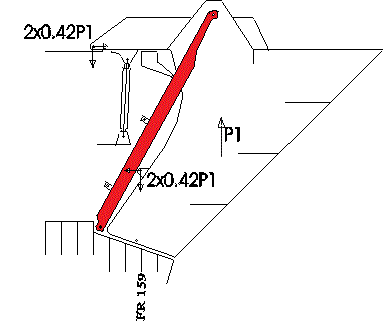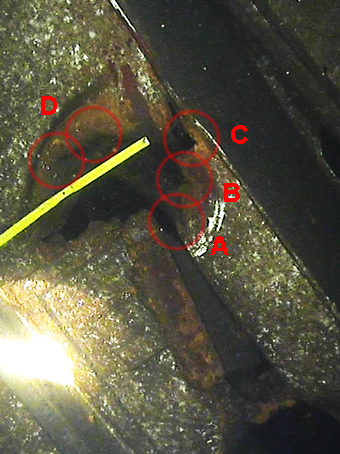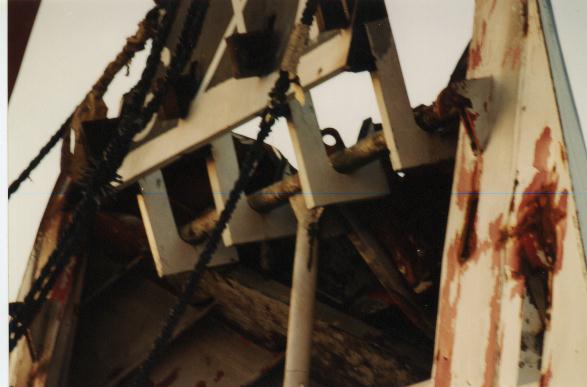3.8 The Accident according to the Commission - the Side Locks
If the Atlantic lock were pulled apart first, as suggested as one possibility of the Commission, the transmission of loads between visor and superstructure would change.
The Final Report (5) has no calculations, where different attachments are not active.
Without the Atlantic lock a vertical load P1 on the visor is transmitted to the hull via the side locks and the hinges. It works very well. Just because one lock fails due to one big wave impact, it doesn't mean that other locks will fail due to further wave impacts.
It is easy to demonstrate that a vertical upward load P1 on the visor is transmitted as a horizontal force 0,42*P1 at every attachment point (two side locks, two hinges). There is tension in the side locks and compression (and bending) in the hinge arms (again we ignore that much external load is transmitted to the superstructure as friction in the vertical rubber seals). See figure 3.8.0 below.
The Atlantic Lock was not needed
|
You see that the Atlantic lock was not required. The visor was still attached by four strong points. Visors were built in such a way in the 1950's and 1960's and it was only to unload and to reduce wear and tear in the hinges, why an Atlantic lock was later installed - to un-load the hinges! The Commission states (see chapter 15.3 in the Final Report (5)) that the load-carrying capacity of the bottom lock was insufficient to satisfy various requirements, but in fact the bottom lock was not required at all. The Commission invented that the Atlantic lock was required for the safety of the ferry while in reality it was only an extra reinforcement to unload the hinges. If the Atlantic lock was broken (at 00.55 hrs?), the horizontal loads in the side locks were reduced (from 0.625*P to 0.42*P1), but the direction was changed - P1 caused a tensile load in the side lock lugs. The Commission then states in the confusingly written Final Report that another impact load P1 (at 01.05 hrs?) on the visor caused another tensile load that pulled the side locks apart, i.e. the side lock lugs were ripped off out/sidewards with parts of the visor aft bulkhead plating. Of course there is no evidence for that. It is another invention of the Commission! |
|
We are told that the 60 mm thick side lugs and pieces of visor bulkhead plates were pulled off the visor, but we do not told why (The lugs (each with a piece of plate from the visor) were never salvaged - they are still down at the wreck). According to the Commission this event may have occurred, when the visor was pushed up by another impact load P1 on the visor at about 01.05 hrs - 10 minutes after the damage to the Atlantic lock, or that it was a simultaneous happening. The Final Report is very unclear as shown in 3.7 - it could also have been the port visor hinge or side lock that broke off first according to the Commission.
The port side lock lug and plate attached to the wreck were filmed on 2 October 1994 (see figure 8.17 in (5)) - the depth indication has been edited away. But the starboard side lock lug and plate, located about five meters deeper down were apparently not filmed on 2 October. First on 9 October 1994 was the starboard side lock lug allegedly filmed - see figure 8.18 in (5) - at 67.6 meters depth. However - strangely enough the Commission/Karppinen did not film the starboard superstructure bulkhead just above the side lock on 9 October 1994. Just above the starboard side lock Czech divers filmed in August 2000 a big opening apparently caused by an explosion 3.10.
Big Damage - but no Damage at all according to the Commission
For unknown reasons the big damage above the starboard side lock is not mentioned in the Final Report (5) at all. Figure 8.18 in (5) is cut off - you cannot see what is above the side lock. The Commission has reported that the starboard front bulkhead of the superstructure is undamaged above the side lock - it is only at the top that the bulkhead connected to the weather deck is allegedly torn open a little (by the visor hydraulics). In reality there is a big opening - 0,6 meters wide and >2 meters long in the bulkhead!
Three ridiculous German Proposals - too much Water inside the Visor ... or an Explosion ... or the Crew opened the Visor
The German group of experts long suggested that the side lock lugs were ripped off, when the visor tipped forward - full of water and with the hinges ripped apart - and rotated around the then undamaged Atlantic lock (it was thus engaged). This suggestion has never been investigated by the Commission. This proposal is quite ridiculous as the Germans never explain how first the hinges and then the side locks can be ripped apart in a forward direction. What force would have caused that?
Later, 1999, the Germans suggested 3.18 that an explosive device between visor and ramp may have contributed to the loss of the visor, i.e. all locks and hinges should have been ripped apart by a bomb exploding between ramp and visor. This is also quite ridiculous - what would have been the purpose of such a criminal act?
|
|
On port side (picture left) the steel plate
below the side lock lug is pulled out resulting in
a rectangular opening. The fractured edges are
not rusty. The double plate
hook plates of the port manual lock below the side
lock lug are pushed together sideway, i.e. it could
not have been used. The starboard manual hook/lugs are ripped apart
and deformed vertically/aftward.The reason for this
damage is unclear - the Commission suggests that
they punched a hole in the front bulkhead but the
Czech divers did not find that hole - they found
instead a 2,5x0,6 meters opening caused by
explosives - see below and The Commission states in the Final report (5) that the manual side locks were not used, but the damages to the starboard manual lock hook evidently show that it must have been used or damaged, when the visor was removed. |
 Fig. 8.20 of (5) Damages to starboard lock lug. The manual lock hook - damaged - below. |
|
On other photos, e.g. right taken immediately after the salvage of the visor, the manual hook is however undamaged! The starboard hook - undamaged - is seen left in the picture. The writer originally thought that the loss of the side lugs were caused by a sideway wave force, when the leaking and listing ferry hit the visor sideways straight down on a wave. This would have been easy to confirm by checking the lugs - scrape marks, but the lugs are still on the wreck. But it is more likely that the visor was attached to the ship, when it sank. Today the writer thinks that the starboard damages were caused, when the visor, still attached to the superstructure starboard side, were removed under water after the accident. Explosives were then used. |
|
Side Locks stronger than expected 1996 and as stated 1994
Not until the ninth meeting of the Commission at Helsinki on 31 January and 1 February 1996 (act A162*) the Finnish delegation announced that they had done full scale tests of the side locks and measured a break load of 214.5 tons for one lock!
According to the calculations above you then needed an outside load of P1 >500 tons to pull them apart. In order for the statements of the Commission in 1994 and in the Final Report in 1997 to be correct, you thus need an initial impact P - 360 tons - to break the Atlantic lock and then another impact P1 - >500 tons - to damage the side locks.
According the Commission it could have been up to ten minutes between the impacts - first an impact P at 00.55 hrs, and then another impact P1 at 01.05 hrs without the crew reacting. But according to the model tests, 3.7 and Appendix 2, there were impacts >300 tons every minute! These model tests are strange, certainly falsified due to incorrect extrapolation of full scale forces from model data - does actually 300 tons impact forces, P and P1, hit a ferry like the 'Estonia' every minute - in 4,2 meters waves? Survivors were alleged by the Commission to have heard repeated metallic noise from the bow for ten minutes before the accident - listing but they never heard any wave impacts. So there were no wave impacts - there were metallic noises, we are told! But the ship's crew did nothing. Metallic noise is quite different from a wave impact. The latter is heard as canon shot followed by vibrations. The reader should by know that any allegation by the Commission about wave impacts on visors are pure imagination.
Freak Waves
Two ships of the writer have been hit by freak - unexpected, steep and high - solid waves in heavy weather causing severe damages. One cargo ship was suddenly rolling into the freaksolid wave, which ripped off 50 metres of bulwark on the weather deck and damaged hatch covers and a crane. The bang was immediately heard and the damage noticed and the ship changed course to a port of refuge. A freak wave on the other ship rolled over the stern and impacted and damaged the deck house aft side - it was pushed in 10-20 centimetres - and smashed windows and doors and the 1st tier of the deck house was water filled. The impact was evidently heard and the ship changed course, etc.
It is strange (evidently the Commission just made up an untrue story!) that the crew on the 'Estonia' never noticed anything suspect before the ship suddenly listed (at 01.02 hrs or 01.15 hrs). According to the model tests Appendix 2 there were very big impacts every two-three minutes but on the ship only two big bangs were noticed - then sudden listing - and a stable condition at reduced list.
Many Things must break before the Ramp is open
Regardless - after the side locks in the superstructure were broken a lot of other things in the superstructure or visor must break in tension before the ship can list (and capsize) due to water loaded in the superstructure -
(i) two visor hinges on top of (the weather) deck 4 eight meters above waterline,
(ii) the foundations of the visor lifting hydraulics inside the superstructure on deck 3,
(iii) the weather deck 4 deck plating, 8 mm thick, on top of the superstructure,
(iv) the strong deck beam at frame 159 P+S below weather deck 4 in the superstructure, and
(v) the top of the superstructure bulkhead forward of frame 159,
(vi) six hook/lock attachments of the ramp protecting the superstructure opening, and finally
(vii) the ramp hydraulics and preventer wires.
Only then the ramp can be pulled fully open around its hinges on deck 2 by a forward force (the lose visor?), so that water can fill the car deck in the superstructure after which the ship capsizes and floats upside down.
All these structural damages must take place before the visor can fall off under way without anybody onboard noticing anything. The Commission has not presented any evidence for any damages except the hinges - only some blurry photos taken 4 October 1994. The analysis of alleged (invented by the Commission) damages thus continues.
---




